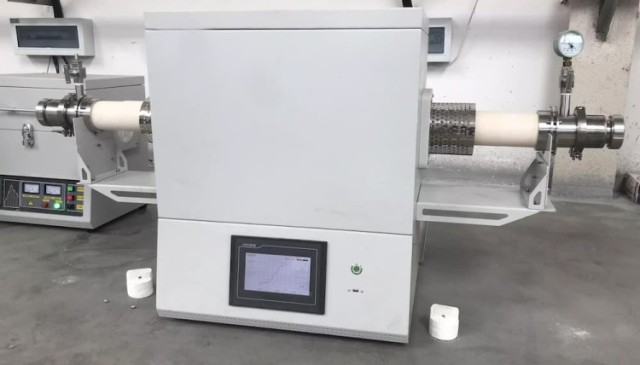What is vacuum tube furnace
A vacuum tube furnace is a type of furnace that uses vacuum to isolate the process atmosphere from the external atmosphere.
This allows for precise control of the process environment and can help to prevent contamination of the materials being heated. Vacuum tube furnaces are used in a variety of industries, including metallurgy, ceramics, electronics, and research.
They are commonly used for heat treatment of materials, such as annealing, sintering, and brazing, as well as for synthesizing and studying the properties of new materials.
Vacuum tube furnaces are typically made of high-temperature resistant materials and are equipped with temperature control and measurement systems to ensure accurate and consistent heating.
How does vacuum tube furnace work
In a vacuum tube furnace, the process chamber is sealed within a tube made of a high-temperature resistant material, such as quartz or ceramic. The tube is typically surrounded by heating elements, which can be made of a variety of materials such as molybdenum, tungsten, or graphite. The heating elements are powered by an electrical current, which causes them to heat up and transfer heat to the tube.
To create a vacuum in the process chamber, a vacuum pump is used to remove air from the tube. This is done by attaching a hose to the inlet port of the vacuum pump and the outlet port to the vacuum flange on the tube. As the pump operates, it draws air out of the tube, creating a vacuum inside the process chamber.
Once the desired level of vacuum has been achieved, the materials to be heated can be placed inside the process chamber. The vacuum in the chamber helps to prevent contamination of the materials and allows for precise control of the process environment.
The temperature of the process chamber is controlled using a thermocouple or other temperature measurement device, and the heating elements can be adjusted as needed to maintain the desired temperature.
The type of atmosphere in vacuum tube furnace
In a vacuum tube furnace, the process chamber is sealed within a tube and the air is removed from the tube using a vacuum pump. This creates a vacuum inside the process chamber, which is a type of atmosphere with a very low pressure. The level of vacuum that can be achieved in a vacuum tube furnace depends on the type and size of the furnace, as well as the materials being used. Some vacuum tube furnaces are designed to operate at rough vacuum levels, while others are capable of achieving high or ultra-high vacuum levels.
In addition to vacuum, it is also possible to work with various gases or gas mixtures in a vacuum tube furnace. This can be done by introducing the desired gas or gas mixture into the process chamber through the inlet port, using a gas cylinder or other source. The vacuum pump can then be used to remove any excess gas or to maintain a specific pressure level within the process chamber.
The type of atmosphere that can be created in a vacuum tube furnace depends on the materials being used and the intended application.
Additionally, as a vacuum furnace allows complete removal of the atmosphere, it is also possible to work with various gases or mixtures, such as Argon, Nitrogen, Hydrogen, Carbon Monoxide, Helium etc. For non-metallic tubes, even corrosive gases, such as Ammonia or Silane among many others become possible.
For example, certain gases or gas mixtures may be needed to create a specific reaction or to study the properties of a material under certain conditions. Vacuum tube furnaces provide a versatile and controlled environment for a wide range of applications and can be used with a variety of gases and gas mixtures.
How to choose vacuum tube furnace type
Vacuum tube furnaces and vacuum chamber furnaces are both types of furnaces that use vacuum to isolate the process atmosphere from the external atmosphere. However, there are some key differences between the two that can impact which type of furnace is most suitable for a particular application.
One key difference between vacuum tube furnaces and vacuum chamber furnaces is size. Vacuum tube furnaces typically have a smaller size and are designed for smaller scale applications. They use a tube made of a high-temperature resistant material, such as quartz or ceramic, to contain the process chamber. The maximum size of the tube and the maximum temperature that can be achieved are generally limited by the materials and design of the furnace.
In contrast, vacuum chamber furnaces are larger and are designed for larger scale applications. They use a chamber made of a high-temperature resistant material, such as stainless steel, to contain the process chamber. The chamber is typically surrounded by heating elements, which can be adjusted to control the temperature within the chamber. Vacuum chamber furnaces are generally able to achieve higher temperatures and can accommodate larger materials or batches than vacuum tube furnaces.
Ultimately, the choice between a vacuum tube furnace and a vacuum chamber furnace will depend on the specific requirements of the application, including the size and temperature needed. Vacuum tube furnaces are well-suited for smaller scale applications with lower temperature requirements, while vacuum chamber furnaces are better suited for larger scale applications with higher temperature requirements.
Related Products
- Vertical Laboratory Tube Furnace
- Laboratory Vacuum Tilt Rotary Tube Furnace Rotating Tube Furnace
- Multi-zone Laboratory Tube Furnace
- Customer Made Versatile CVD Tube Furnace Chemical Vapor Deposition Chamber System Equipment
- Vacuum Sealed Continuous Working Rotary Tube Furnace Rotating Tube Furnace
Related Articles
- Ultimate Guide to High Pressure Tube Furnaces: Applications, Types, and Benefits
- Installation of Tube Furnace Fitting Tee
- The Versatility of Tube Furnaces: A Guide to Their Applications and Benefits
- Infrared Heating Quantitative Flat Plate Mold: Design, Applications, and Benefits
- Exploring the Key Characteristics of Tube Heating Furnaces


















